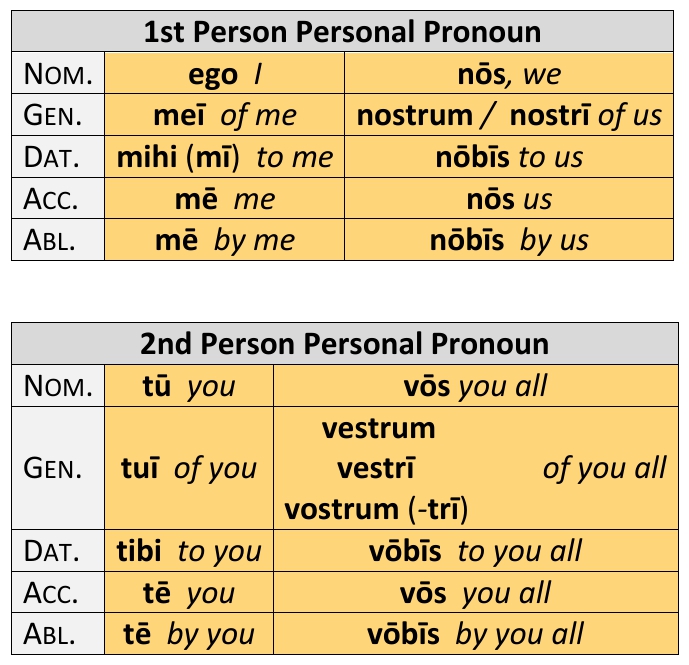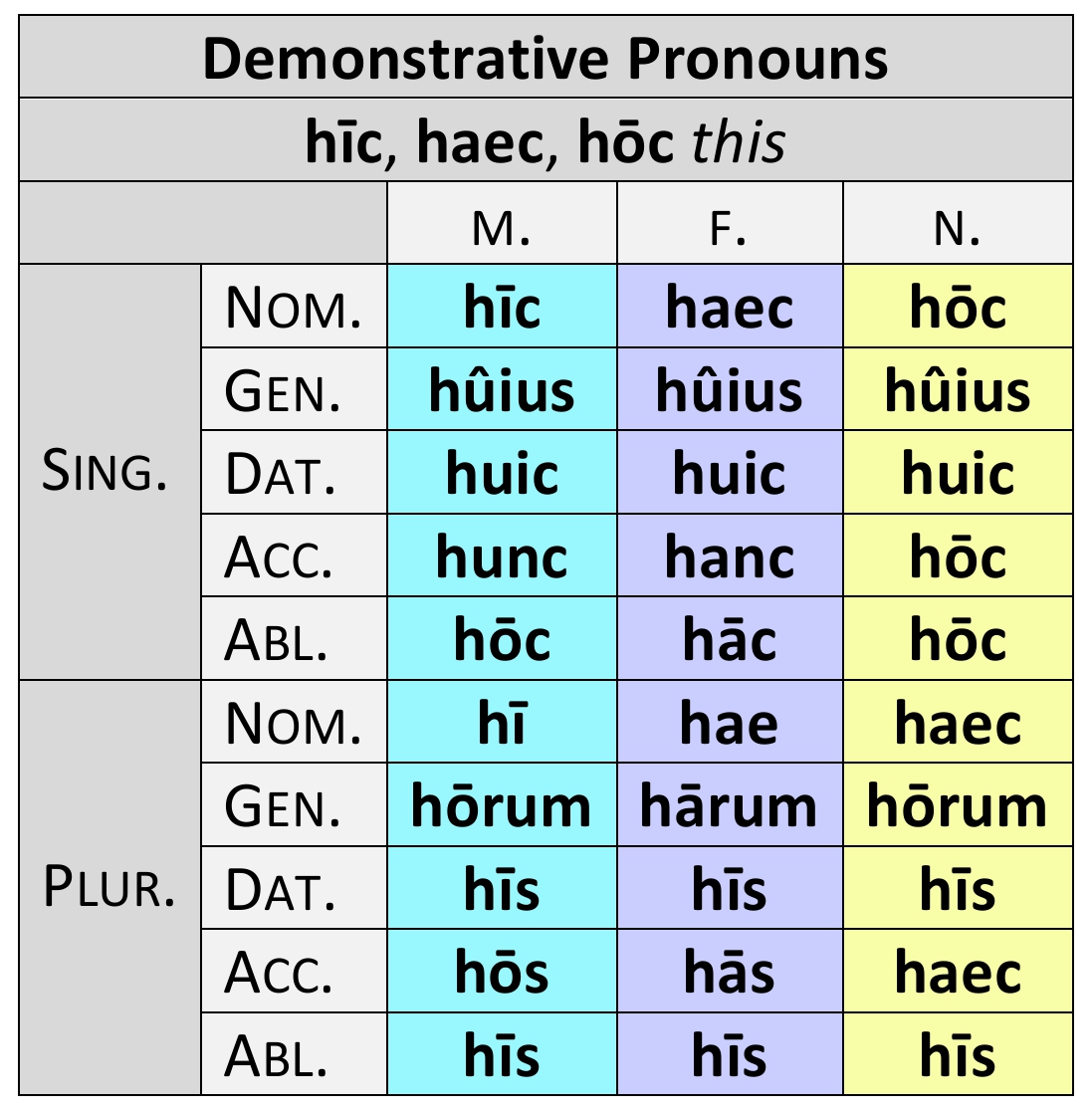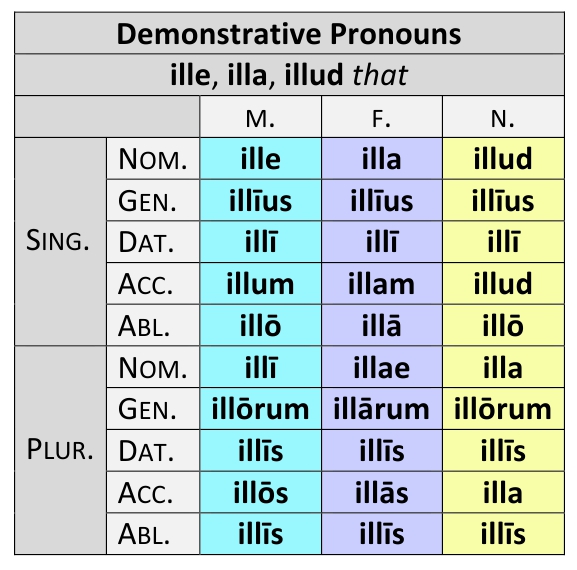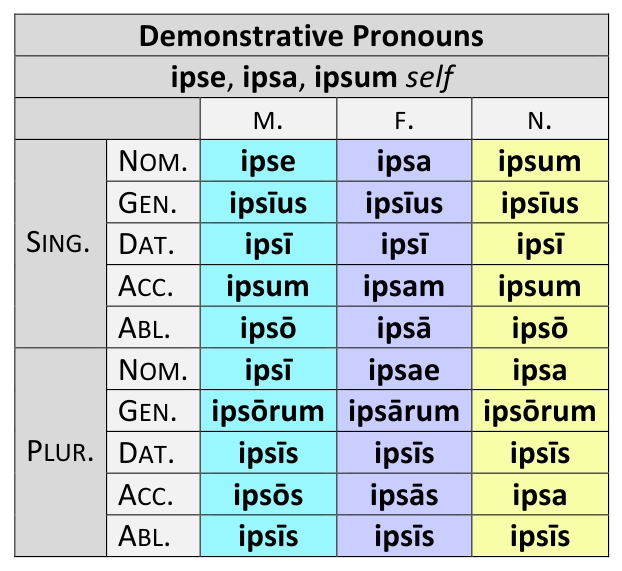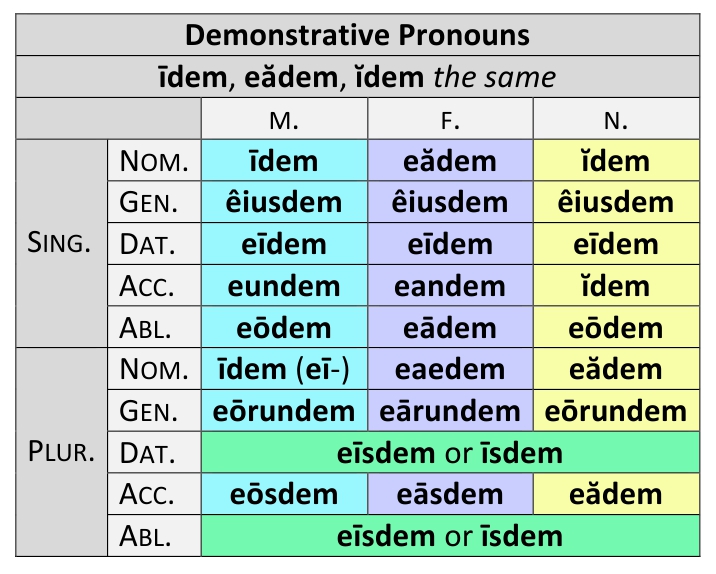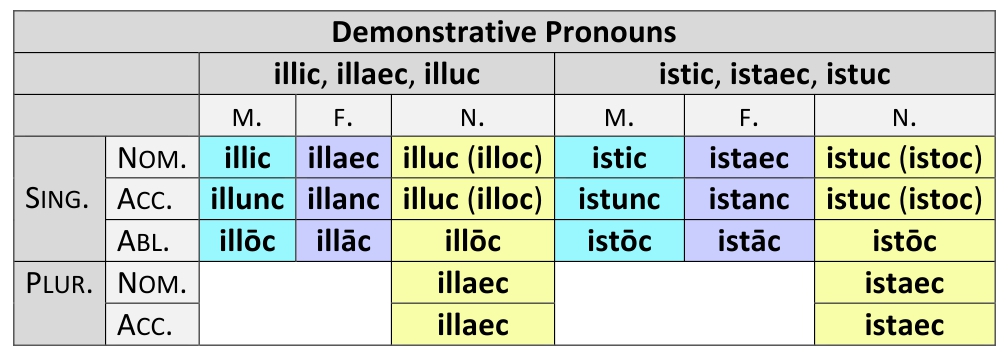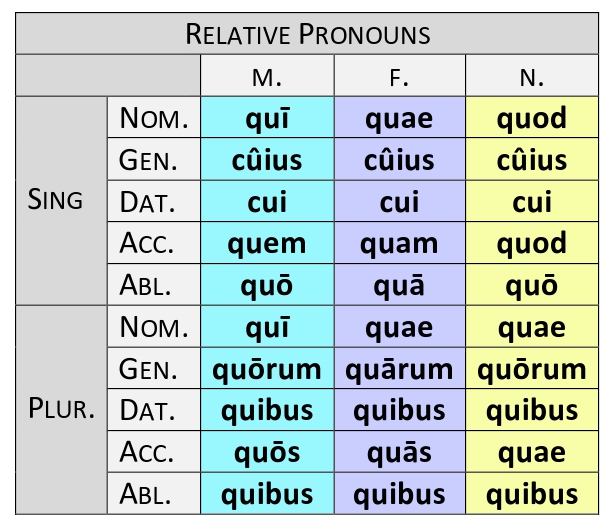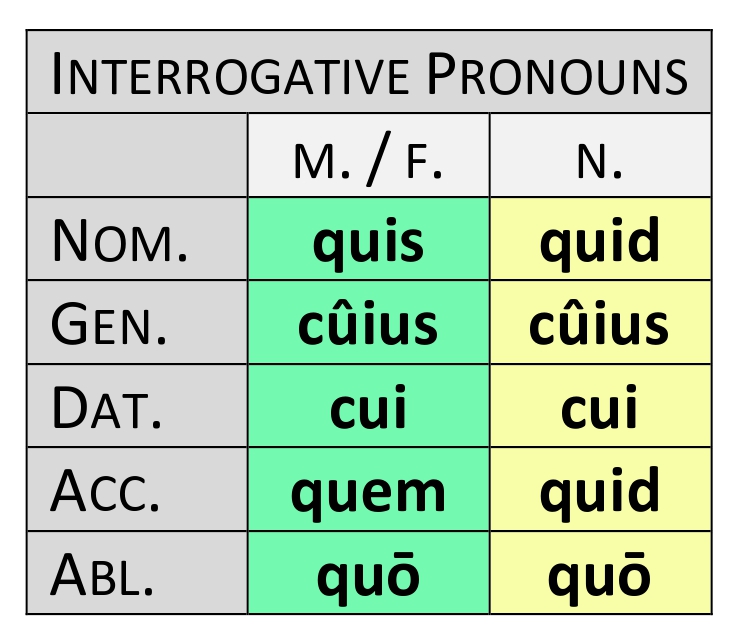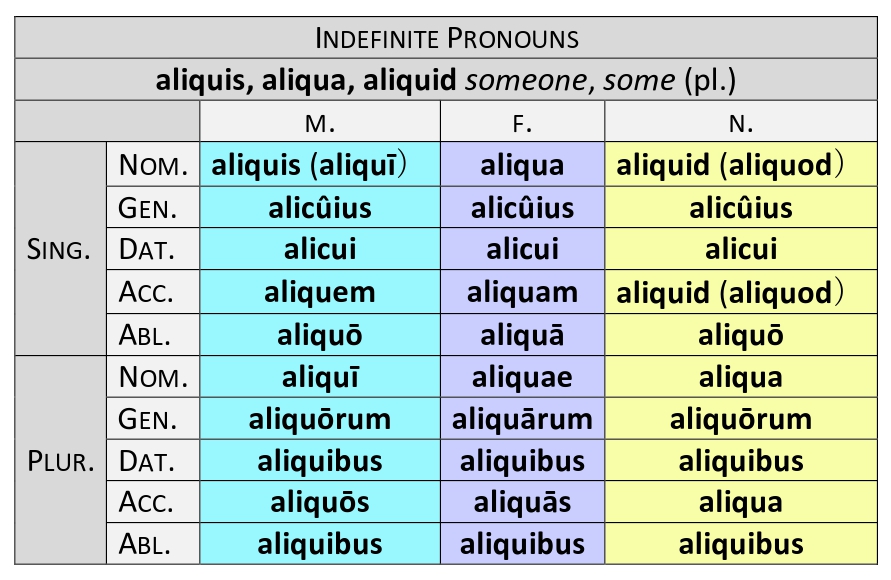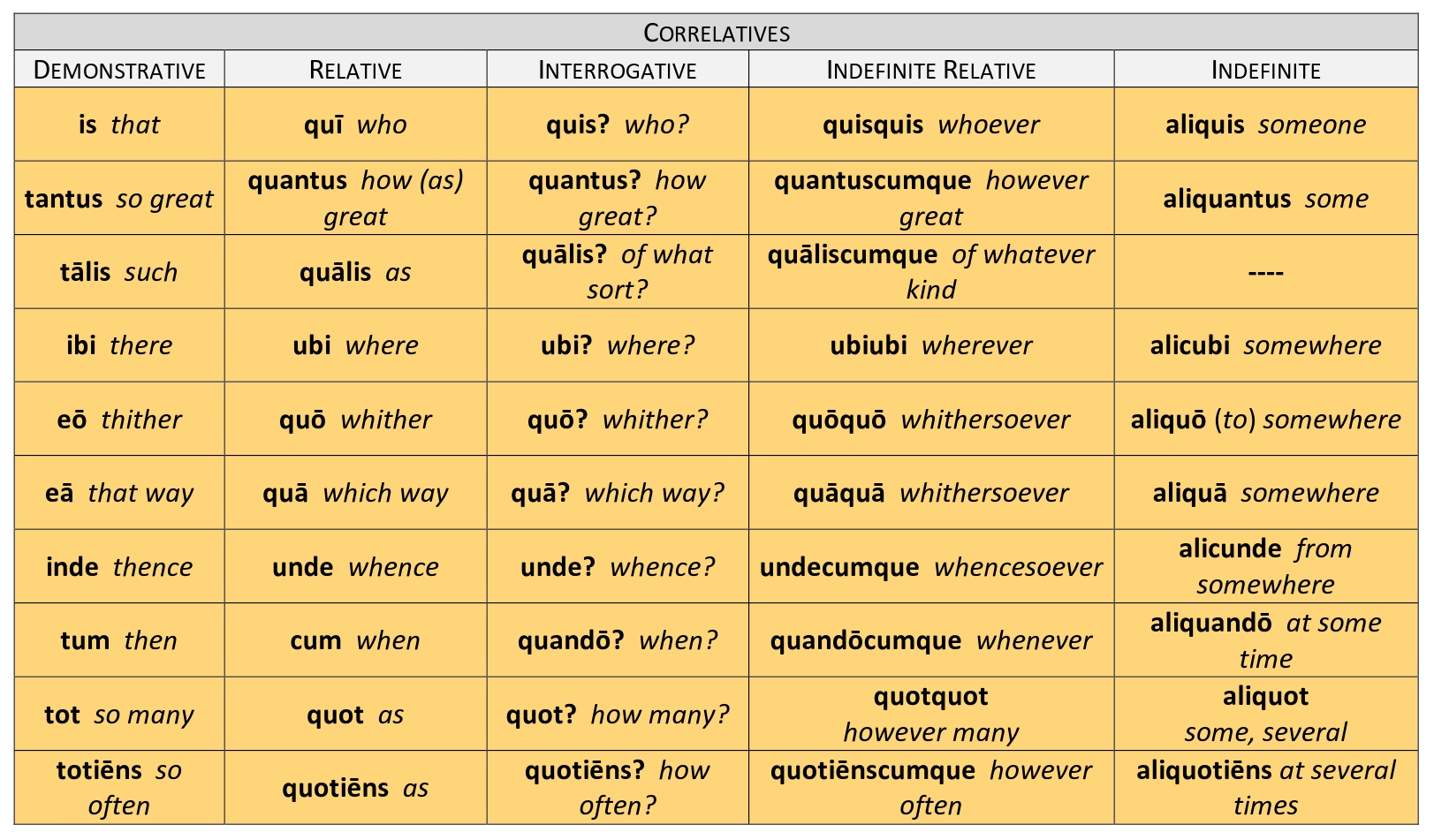PRONOUNS
PRONOUNS: CLASSES
140. Pronouns are used as Nouns or as Adjectives. They are divided into seven classes.
- Personal Pronouns.
ego I
- Reflexive Pronouns.
sē himself
- Possessive Pronouns.
meus my
- Demonstrative Pronouns.
hīc this, ille that
- Relative Pronouns.
quī who
- Interrogative Pronouns.
quis who?
- Indefinite Pronouns.
aliquis some one
141. Pronouns have special forms of declension.
Note— These special forms are, in general, survivals of a very ancient form of declension differing from that of nouns.
PERSONAL PRONOUNS: PARADIGM
142. The Personal pronouns are as follows.
1st person: ego I, nōs we
2nd person: tū you, vōs you (all)
The personal pronouns of the 3rd person—he, she, it, they—are wanting in Latin, a demonstrative being sometimes used instead.
143. Ego and tū are declined below.
a. The plural nōs is often used for the singular ego the plural vōs is never so used for the singular tū.
Note— Old forms are genitive mīs, tīs; accusative and ablative mēd, tēd (cf. § 43, Note 1)
b. The forms nostrum, vestrum, etc., are used partitively.
ūnusquisque nostrum each one of us
vestrum omnium of all of you
Note— The forms of the genitive of the personal pronouns are really the genitives of the possessives.
meī, tuī, suī, nostri, vestrī (genitive singular neuter)
nostrum, vestrum (genitive plural masculine or neuter)
So in early and later Latin we find ūna vestrārum one of you (women).
c. The Genitives meī, tuī, suī, nostri, vestrī are chiefly used objectively (§ 347).
memor sīs nostrī be mindful of us (me)
mē tuī pudet I am ashamed of you
d. Emphatic forms of tū are tūte and tūtemet (tūtimet). The other cases of the personal pronouns, excepting the genitive plural, are made emphatic by adding -met.
egomet
vōsmet
Note— Early emphatic forms are mēpte and tēpte.
e. Reduplicated forms are found in the accusative and ablative singular.
mēmē
tētē
f. The preposition cum (with) is joined enclitically with the ablative.
Tēcum loquitur. He talks with you.
REFLEXIVE PRONOUNS: PARADIGM
144. Reflexive Pronouns are used in the Oblique Cases to refer to the subject of the sentence or clause in which they stand (see § 299).
Sē amat. He loves himself.
a. In the 1st and 2nd persons the oblique cases of the Personal pronouns are used as Reflexives.
Mē videō. I see myself.
Tē laudās. You praise yourself.
Nōbīs persuādēmus. We persuade ourselves.
b. The Reflexive pronoun of the 3rd person has a special form used only in this sense, the same for both singular and plural. It is declined as follows.
Note 1— Emphatic and reduplicated forms of sē are made as in the personals (see § 143.d-e). The preposition cum is added enclitically.
sēcum with himself, etc.
Note 2— An old form sēd occurs in the Accusative and Ablative.
POSSESIVE PRONOUNS: PARADIGM
145. The Possessive pronouns are as follows.
These are really adjectives of the 1st and 2nd Declensions, and are so declined (see § 110 - § 112). But meus has regularly mī (rarely meus) in the vocative singular masculine.
Note— Suus is used only as a reflexive, referring to the subject. For a possessive pronoun of the 3rd person not referring to the subject, the genitive of a demonstrative must be used.
Patrem suum occīdit. He killed his (own) father.
BUT
Patrem êius occīdit. He killed his (somebody else's) father.
a. Emphatic forms in -pte are found in the ablative singular.
suōpte
b. A rare possessive is formed from the genitive singular of the relative or interrogative pronoun quī, quis.
cûius (quôius), -a, -um whose
It may be either interrogative or relative in force according to its derivation, but is usually the former.
c. The reciprocals one another and each other are expressed by inter sē or alter . . . alterum.
alter alterīus ōva frangit
they break each other's eggs (one . . . of the other)
inter sē amant
they love one another (they love among themselves)
DEMONSTRATIVE PRONOUNS: PARADIGMS
146. The Demonstrative Pronouns are used to point out or designate a person or thing for special attention, either with nouns as Adjectives or alone as Pronouns. They are: hīc (this); is, ille, iste (that), with the intensive ipse (self), and īdem (same)1 and are declined below.
Note 1— Hīc is a compound of the stem ho- with the demonstrative enclitic -ce. In most of the cases final e is dropped, in some the whole termination. But in these latter it is sometimes retained for emphasis.
hûius-ce, hīs-ce
In early Latin -c alone is retained in some of these (hōrunc). The vowel in hīc, hōc, was originally short, and perhaps this quantity was always retained. Ille and iste are sometimes found with the same enclitic.
illic, illaec, illuc
Also illoc. See a below.
Note 2— For the dative and ablative plural of hīc the old form hībus is sometimes found; haec occurs (rarely) for hae.
Note 3— Obsolete forms are eae (Dat. fem.), and eābus or ībus (Dat. plur.). Êī and ei (monosyllabic) are also found for dative eī; ei, eos, etc., also occur in the plural.
Iste, ista, istud [that (yonder)] is declined like ille.
Note 4— Ille replaces an earlier ollus (olle), of which several forms occur.
Note 5— Iste is sometimes found in early writers in the form ste etc. The first syllable of ille and ipse is very often used as short in early poetry.
Note 6— The forms illī, istī (gen.), and illae, istae (dat.), are sometimes found; also the nominative plural istaece, illaece (for istae, illae). See a below.
Note 7— Ipse is compounded of is and -pse (a pronominal particle of uncertain origin: cf. § 145.a), meaning self. The former part was originally declined, as in reāpse (for rē eāpse in fact). An old form ipsus occurs, with superlative ipsissimus (own self), used for comic effect.
Note 8— The intensive -pse is found in the forms eapse (nominative), eumpse, eampse, eōpse, eāpse (ablative).
Note 9— Īdem is the demonstrative is with the indeclinable suffix -dem. The masculine īdem is for †isdem; the neuter idem, however, is not for †iddem, but is a relic of an older formation. A final m of is is changed to n before d (eundem for eumdem, etc.) The plural forms īdem, īsdem, are often written iīdem, iīsdem.
a. Ille and iste appear in combination with the demonstrative particle -c, shortened from -ce, in the following forms.
Note 1— The appended -ce is also found with pronouns in numerous combinations
hûiusce, hunce
hōrunce, hārunce
hōsce,
hīsce (cf. Note 1 above)
illīusce, īsce
Also with the interrogative -ne, in hōcine, hōscine, istucine, illicine, etc.
Note 2— The following are formed by composition with ecce or em (behold!).
eccum (for ecce eum), eccam, eccōs, eccās
eccillum (for ecce illum)
ellum (for em illum), ellam, ellōs, ellāseccistam.
These forms are dramatic and colloquial.
b. The combinations hûiusmodī (hûiuscemodī), êiusmodī, etc., are used as indeclinable adjectives, equivalent to tālis such.
rēs êiusmodī such a thing (a thing of that sort; cf. § 345.a).
For uses of the Demonstrative Pronouns, see § 296 .
Footnotes
RELATIVE, INTERROGATIVE AND INDEFINITE PRONOUNS: PARADIGM
147. The Relative Pronoun quī (who, which) is declined as follows.
148. The Substantive Interrogative Pronoun quis (who?) quid (what?) is declined in the Singular as follows.
The Plural is the same as that of the Relative quī, quae, quae.
a. The singular quis is either masculine or of indeterminate gender, but in old writers it is sometimes distinctly feminine.
b. The Adjective Interrogative Pronoun quī, quae, quod (what kind of? what? which?) is declined throughout like the Relative.
| SUBSTANTIVE | ADJECTIVE |
| quis vocat who calls? | quī homō vocat what man calls? |
| quid vidēs what do you see? |
quod templum vidēs what temple do you see? |
Note— But quī is often used without any apparent adjective force; and quis is very common as an adjective, especially with words denoting a person.
Quī nōminat mē? Who calls my name?
Quis diēs fuit? What day was it?
Quis
homō? What man?
But often
Quī homō? What kind of man?
Nesciō quī sīs. I know not who you are.
c. Quisnam (pray, who?) is an emphatic interrogative. It has both substantive and adjective forms like quis, quī.
149. The Indefinite Pronouns quis (any one) and quī (any) are declined like the corresponding Interrogatives, but qua is commonly used for quae except in the nominative plural feminine.
| SUBSTANTIVE | quis any one quid anything |
| ADJECTIVE | quī, qua (quae), quod any |
a. The feminine forms qua and quae are sometimes used substantively.
b. The indefinites quis and quī are rare except after sī, nisi, nē, and num, and in compounds (see § 310.a-b).
Note— After these particles quī is often used as a substantive and quis as an adjective (cf. § 148.b Note, above).
150. The Relative, Interrogative, and Indefinite Pronouns are originally of the same stem, and most of the forms are the same (compare § 147 with § 148, above). The stem has two forms in the masculine and neuter, quo-, qui-, and one for the feminine, quā-. The interrogative sense is doubtless the original one.
a. Old forms for the genitive and dative singular are quôius, quoi.
b. The form quī is used for the ablative of both numbers and all genders; but especially as an adverb (how, by which way, in any way), and in the combination quīcum (with whom), as an interrogative or an indefinite relative.
c. A nominative plural quēs (qui-) occurs in early Latin. A dative and ablative plural quīs (quo-) is found even in classic Latin.
d. The preposition cum is joined enclitically to all forms of the ablative, as with the personal pronouns (§ 143.f).
quōcum, quīcum, quibuscum
Note— But occasionally cum precedes.
cum quō (Iuv. 4.9).
151. The pronouns quis and quī appear in various combinations. The adverb -cumque (-cunque; cf. quisque) added to the relative makes an indefinite relative, which is declined like the simple word.
quīcumque, quaecumque, quodcumque (whoever, whatever) cûiuscumque, etc.
Note— This suffix, with the same meaning, may be used with any relative
quāliscumque of whatever sort
quandōcumque (also rarely quandōque) whenever
ubicumque wherever
a. In quisquis (whoever) both parts are declined, but the only forms commonly used are quisquis, quidquid (quicquid), and quōquō.
Note 1— Rare forms are quemquem and quibusquibus; an ablative quīquī is sometimes found in early Latin; the ablative feminine quāquā is both late and rare. Cuicui occurs as a genitive in the phrase cuicui modī (of whatever kind).Other cases are cited, but have no authority. In early Latin quisquis is occasionally feminine.
Note 2— Quisquis is usually substantive, except in the ablative quōquō, which is more commonly an adjective.
c. The indefinite pronouns quīdam [a certain (one)], quīvīs, quīlibet (any you please) are used both as substantives and as adjectives. The first part is declined like the relative quī, but the neuter has both quid- (substantive) and quod- (adjective).
| quīdam | quaedam | quiddam (quoddam) |
| quīvīs | quaevīs | quidvīs (quodvīs) |
Quīdam changes m to n before d in the accusative singular [quendam (m.), quandam (f.)] and the genitive plural [quōrundam (m. / n.), quārundam (f.)].
d. The indefinite pronouns quispiam (some, any) and quisquam (any at all) are used both as substantives and as adjectives. Quispiam has feminine quaepiam (adjective), neuter quidpiam (substantive) and quodpiam (adjective); the plural is very rare. Quisquam is both masculine and feminine; the neuter is quidquam (quicquam), substantive only; there is no plural. Ūllus, -a, -um, is commonly used as the adjective corresponding to quisquam.
e. The indefinite pronoun aliquis (some one, substantive), aliquī (some, adjective), is declined like quis and quī, but aliqua is used instead of aliquae except in the nominative plural feminine.
Note— Aliquī is sometimes used substantively and aliquis as an adjective.
f. The indefinite pronoun ecquis (whether any one, substantive), ecquī (whether any, adjective), is declined like aliquis, but has either ecquae or ecqua in the nominative singular feminine of the adjective form.
Note— Ecquis (ecquī) has no genitive singular, and in the plural occurs in the nominative and accusative only.
g. The enclitic particle -que added to the interrogative gives a universal
quisque every one
uterque each of two, or both.
Quisque is declined like the interrogative quis, quī
quisque, quidque (substantive)
quīque, quaeque, quodque (adjective)
In the compound ūnusquisque (every single one) both parts are declined (genitive unīuscûiusque), and they are sometimes written separately and even separated by other words.
nē in ūnō quidem quōque not even in a single one (Lael. 92)
h. The relative and interrogative have rarely a possessive adjective cûius, -a, -um (whose; older quôius) and a patrial cûiās (cûiāt-), of what country.
i. Quantus (how great) quālis (of what sort) are derivative adjectives from the interrogative. They are either interrogative or relative, corresponding respectively to the demonstratives tantus, tālis (§ 152). Indefinite compounds are quantuscumque and quāliscumque (see § 151.a, above).
CORRELATIVES
152. Many Pronouns, Pronominal Adjectives, and Adverbs have corresponding demonstrative, relative, interrogative, and indefinite forms. Such parallel forms are called Correlatives. They are shown in the following table.
